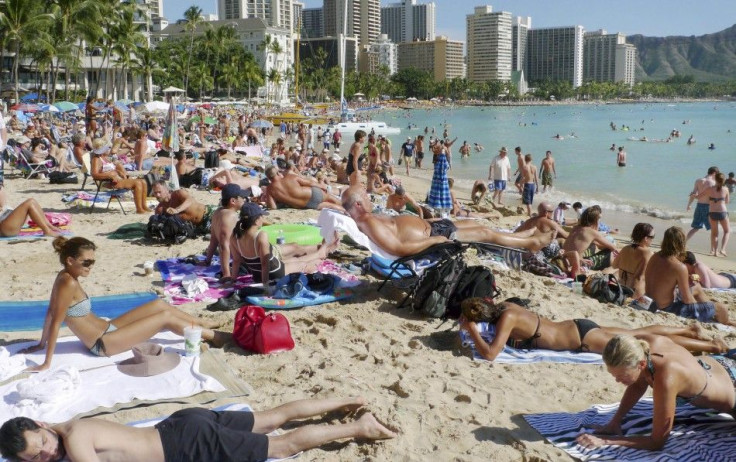Hawaiian Tourism Industry Devastated By Coronavirus-Related Job Losses

KEY POINTS
- Hawaii had 73 jobless claim filings for every 1,000 workers, the highest such rate in the country.
- Tens of thousands have lost jobs as hotels, bars, restaurants, retail stores in Hawaii
- Hawaii’s unemployment rate has skyrocketed from 2.7% to more than 10%
A record 6.6 million Americans filed for unemployment benefits last week as the coronavirus pandemic has shut down businesses across the country.
On a per capita basis, no state has filed more claims than Hawaii – 73 filings for every 1,000 workers (Pennsylvania ranked second with 62 filings per 1,000 workers).
Hawaii has been particularly hit hard because its top industry, tourism and hospitality, has been devastated by the travel bans spurred by the pandemic. Tens of thousands have lost jobs as hotels, bars, restaurants, retail stores and other businesses have shuttered in response to a plunge in tourism.
For all of March, total unemployment filings in Hawaii amounted to 160,929 (in a state with a population of only about 1.42 million), according to the state’s Department of Labor and Industrial Relations, or DLIR. (However, that 160,929 figure likely included some repeat filings)
Since January, Hawaii’s unemployment rate has skyrocketed from 2.7% to more than 10%, as tourism has virtually halted.
Gov. David Ige has mandated a stay-in-place order that will disrupt local businesses through the end of April. Ige has also ordered 14-day quarantine for both trans-Pacific and inter-island passengers.
Since Mar. 26, only 1,067 visitors have come to Hawaii.
Moreover, Honolulu Mayor Kirk Caldwell, Kauai Mayor Derek Kawakami and Maui Mayor Mike Victorino want to increase travel lockdowns, by seeking to end all non-essential travel to Hawaii.
These measures are likely to accelerate job losses.
In fact, so many people started filing claims since March that the DLIR’s web portal became overloaded and crashed before the system was improved and restored.
“We’ve been getting calls from workers. Some of them say they have been trying [to file claims] every hour of every day,” said Bryant de Venecia, spokesman for the Unite Here Local 5 labor union. “We had one worker who began trying to apply on Mar. 22 and only got in Monday, eight days later. The benefit is supposed to cover from the first day out of work, but timing can mean the difference between being able to eat or pay [one’s] rent.”
DLIR spokesman Bill Kunstman assured: “We have internally re-allocated staffing so we have an additional 45 staff working on unemployment matters. We’re working with [the state Department of Human Resources Development] to deploy other state workers for [unemployment insurance].”
Dave Moskowitz, who lost his job at BLT Steak Waikiki, said: “My hours had already been cut a few weeks ago. I was expecting the layoff. Hotel occupancy and visitor arrivals have plummeted. Employers are trying to keep workers on the payroll, but there’s only so much they can do. It’s somber in Waikiki -- workers are very scared. Before this is over, I think lots of people will be out of work, and that’s going to have a trickle-down impact throughout the whole economy.”
Last year, Hawaii’s tourist economy employed 216,000 people, generated $18 billion in visitor spending and contributed $2 billion in tax revenue.
Beyond lost tourism dollars, stores and businesses across the islands have closed.
Hawaiian Airlines, which has more than 7,400 workers, imposed a hiring freeze, slapped salary cuts on senior executives and told employees they could take voluntary unpaid leave, with benefits.
Retailer have also been especially hit hard.
“When [the crisis] first started, people were seeing their hours cut, “said Tina Yamaki, president of Retail Merchants of Hawaii. “Since then some employers have been looking at layoffs or cutting salaries to keep everyone employed… Some employers are evaluating their budget. I’ve heard from others that were barely hanging on that if this goes on for a few more months, they’ll probably have to shut their doors.”
Hotels have also suffered deep losses and will likely see conditions worsen in the coming weeks.
Ben Rafter, CEO of OLS Hotels & Resorts, said: “Anything [we’ve] seen today, we’ll see far more [in the near future]. It’s a difficult situation. I’m glad to see the state ramping up its ability to process unemployment claims. The losses won’t just come from hotels and local attractions; they’ll come from all over.”
A report from the University of Hawaii Economic Research Organization, or UHERO, predicts 140,000 jobs could vanish from the state by June, and that it may takes years to recover from this economic shock.
“While it is too early to assess the full impact of these dramatic actions on Hawaii’s economy, it is clear that they will be sharp and painful,” the report said.
Personal income for residents is expected to drop by nearly 6% from 2019, while the unemployment rate could reach 13.7%. Employment levels may recover until at least 2023.
“We know Hawaii is already in a deep recession,” said Carl Bonham, UHERO’s executive director. “That recession will surpass anything we’ve seen in our lifetimes. There’s no comparison you could make to an economy that’s basically shut down hospitality and tourism. Even [if] the crisis wanes in Hawaii, it will still take time to return to previous economic levels.”
However, the federal government’s coronavirus stabilization package is expected to bring $4 billion in federal money to Hawaii, which will help mitigate some of the economic pain. Congress may also come up with more relief packages in the next few months.
© Copyright IBTimes 2024. All rights reserved.




















